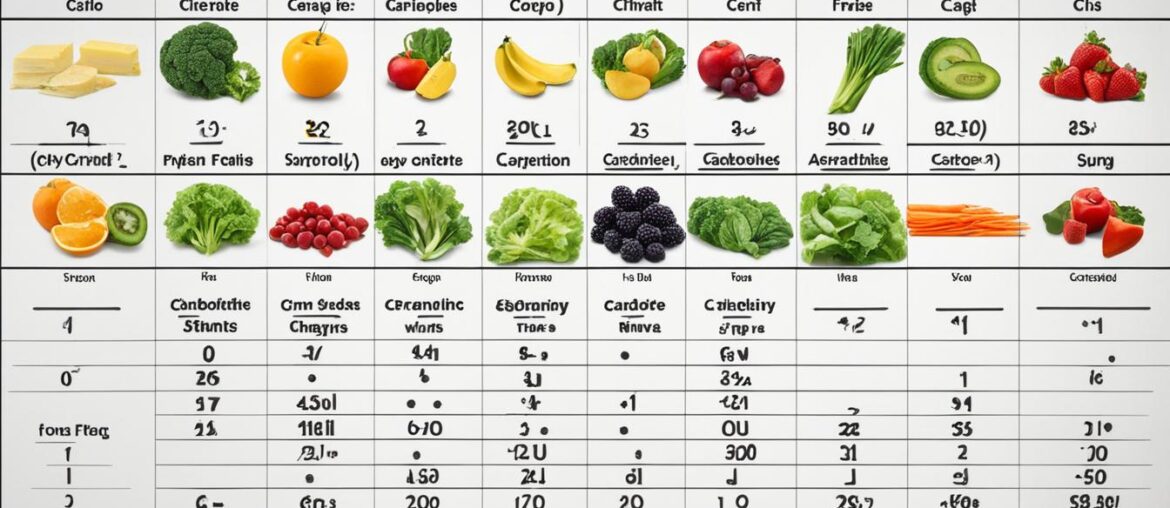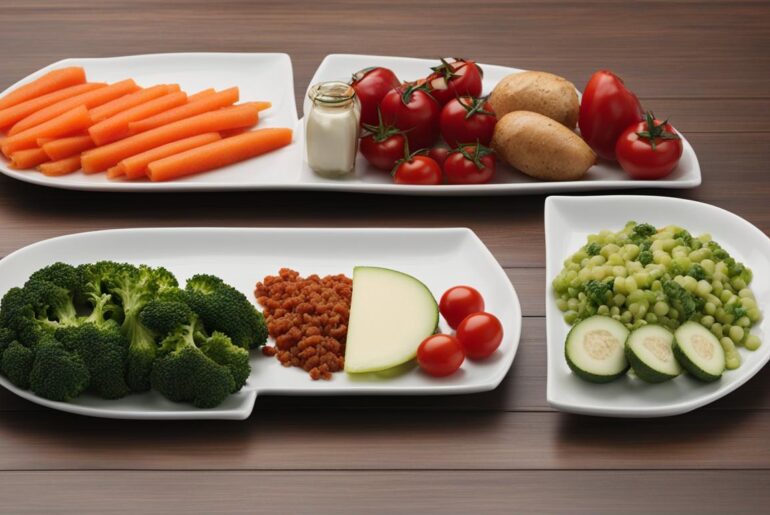Are you looking for a simple and effective way to manage your food portions and promote healthier eating habits? Look no further than my Food Portion Control Chart. With the right portion sizes, you can enjoy your meals while maintaining a balanced diet and reaching your health goals.
Many of us struggle with portion control, leading to overeating and weight gain. But by being mindful of our food serving sizes, we can prevent these issues and improve our overall well-being.
One of the easiest ways to optimize your meals is by using a smaller plate. Research suggests that using a smaller plate can trick your brain into feeling more satisfied with standard-sized portions. This simple trick can prevent overloading and help you maintain healthy portion sizes.
It’s also important to be selective with your seconds. Instead of reaching for high-calorie desserts, opt for a serving of fruits or a healthier alternative. Wait for at least 20 minutes before considering a second helping to allow your body to register fullness. This delay can prevent mindless eating and unnecessary calorie intake.
Another useful strategy is to check food labels to understand recommended portion sizes (check out my post on recommended portion sizes here). Knowing the appropriate serving size can help you make better-informed choices and avoid overeating. Additionally, when dining out, you can ask for smaller portions or skip extras like bread or chips.
Eating foods with lower energy density can also make a significant difference. Energy density is the number of calories per gram of food. By swapping out high-calorie foods for lower-calorie alternatives, you can enjoy a satisfying meal while reducing your overall calorie intake.
My Food Portion Control Chart serves as a visual guide to help you understand and implement these portion control strategies (check this post out). It provides you with the right portion size for different food groups, making it easier to create balanced and nutritious meals.
Key Takeaways:
- Using a smaller plate can make standard-sized portions feel more satisfying.
- Be selective with your seconds, opting for fruits over high-calorie desserts.
- Wait 20 minutes before reaching for a second helping to allow yourself to feel full.
- Check food labels to understand portion sizes.
- When eating out, ask for smaller portions or skip extras like bread or chips.
- Choose less energy-dense options by swapping out high-calorie foods for lower-calorie alternatives.
The Importance of Portion Control for Weight Loss
Proper portion control plays a crucial role in achieving and maintaining weight loss. When we consume more calories than our bodies need, it can lead to weight gain. This is why portion control is essential for effective weight management (check out my post on effective weight management here).
One of the main culprits of overeating is oversized portions, especially those served at restaurants. These large portions can easily tempt us to consume more food than necessary, contributing to excess calorie intake.
By practicing portion control, we can gauge how much food we’re actually consuming and make conscious choices about our eating habits. This helps prevent overeating and promotes weight loss.
There are various strategies for portion control that can be effective in managing our intake:
- Reading nutrition labels: Paying attention to serving sizes listed on food labels can provide valuable information about appropriate portion sizes. This allows us to make informed decisions about the amount of food we consume.
- Planning meals: Preparing meals in advance and having a well-thought-out meal plan can help us control portion sizes and avoid impulsive overeating.
- Measuring food: Using measuring cups or a kitchen scale to measure food portions ensures accuracy and helps us avoid underestimating or overestimating portion sizes.
- Using smaller plates: Research suggests that using smaller plates can create an illusion of a full plate and make us feel satisfied with smaller portions.
By incorporating these portion control tips into our daily routine, we can take control of our eating habits and work towards our weight loss goals (see my post here).
Remember, portion control is not about depriving ourselves of food or following strict diets. It’s about finding a balance and ensuring we’re consuming the right amount of food that our bodies need for optimal health.
“Proper portion control helps us gauge how much food we’re consuming, preventing overeating and promoting weight loss.”
How Portion Size Affects Energy Intake
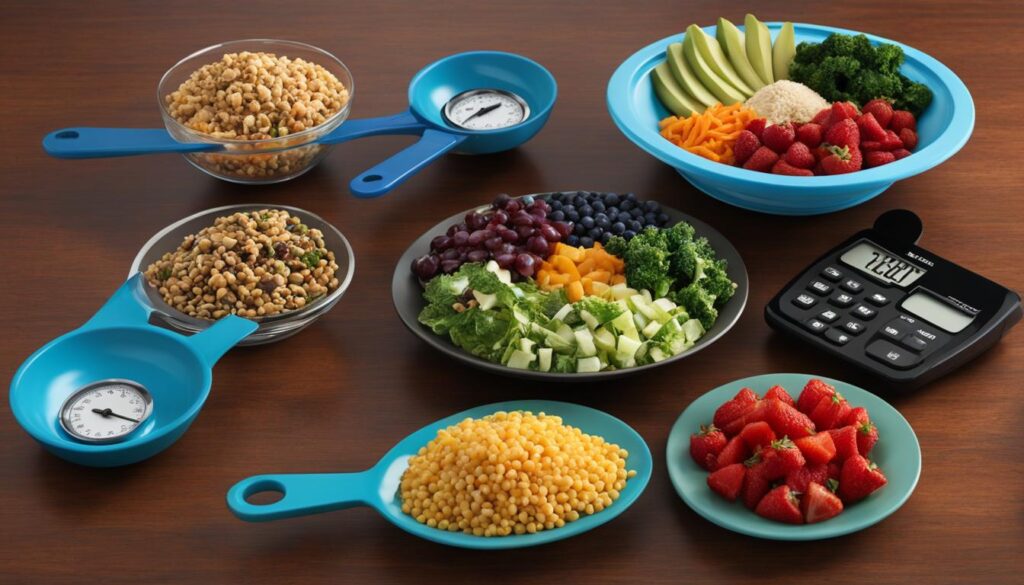
When it comes to managing our food intake, portion size plays a critical role in determining our energy intake. Numerous studies have shown that larger portions lead to increased energy consumption, which can contribute to weight gain and other health issues.
However, there is good news: by implementing effective portion control methods and utilizing portion control tools, we can make positive changes to our eating habits and manage our weight more effectively (check out my post on portion control methods here).
One effective approach to portion control is using portion control plates and tools (see my post here). These specially designed plates and tools help individuals visualize and select appropriate portions, making it easier to maintain a balanced and healthy diet. By using these tools, individuals can avoid the temptation to overeat and establish healthier eating patterns.
In addition to portion control plates and tools, pre-portioned foods can also be a valuable resource. These foods are pre-packaged in specific serving sizes, which adds structure to meals and minimizes the need for decision-making regarding portion sizes. By simplifying the process, pre-portioned foods can make portion control easier and more manageable for individuals seeking to control their energy intake.
Overall, incorporating portion control methods and tools into our daily lives can have a significant impact on weight loss and weight maintenance. By being mindful of portion sizes and utilizing these tools, we can make positive changes in our eating habits and improve our overall health.
The Benefits of Portion Control: A Summary
To summarize, here are the key benefits of implementing portion control methods and utilizing portion control tools:
- Helps manage energy intake and prevent overeating
- Aids in weight loss and weight maintenance efforts
- Provides structure and simplicity to meal planning
- Enables individuals to make informed and mindful food choices
- Promotes healthier eating habits and overall well-being
By incorporating portion control into our daily routine, we can take a proactive approach to managing our energy intake, achieving and maintaining a healthy weight, and promoting a balanced diet.
The Link Between Portion Size and Obesity
Portion sizes in the United States have significantly increased over the years, and this trend may contribute to the prevalence of overweight and obesity among individuals. Larger portions, particularly those served at restaurants, can lead to overeating and weight gain. Therefore, understanding and controlling portion sizes is essential for effective weight management.
One helpful tool in achieving healthy portion sizes is a portion size calculator. This calculator takes into account various factors such as age, gender, weight, and activity level to determine the appropriate amount of food for an individual. By using a portion size calculator, individuals can ensure that they are consuming the right amount of food to meet their weight loss or maintenance goals.
Following portion control guidelines is another effective strategy to manage portion sizes. These guidelines provide recommendations on the serving sizes of different food groups, helping individuals make informed decisions about their food intake. By adhering to these guidelines, individuals can avoid overeating and maintain a healthy weight.
Quote:
“Understanding appropriate portion sizes is crucial for successful weight management. By controlling portion sizes and following portion control guidelines, individuals can take charge of their nutritional intake and achieve their health goals.”
Importance of Healthy Portion Sizes
Knowing how much to eat is vital for maintaining a healthy weight. Consuming excessively large portions can lead to overconsumption of calories, which can contribute to weight gain and the development of obesity-related health issues, such as diabetes and heart disease.
On the other hand, consuming portions that are too small may not provide adequate nutrition, leaving individuals feeling unsatisfied or hungry. Striking a balance and adopting healthy portion sizes can ensure that individuals are getting the right amount of nutrients without excess calories.
Benefits of Portion Control
Portion control offers several benefits for weight management and overall health. By monitoring and controlling portion sizes, individuals can:
- Prevent overeating and reduce caloric intake
- Maintain a healthier weight
- Improve digestion and promote regular bowel movements
- Prevent nutrient deficiencies by consuming a well-balanced diet
Awareness of portion sizes is particularly important when dining out. Restaurants often serve larger portions than what is considered a healthy serving size. By being mindful of portion sizes, individuals can make healthier choices when eating out and avoid consuming excessive calories.
Proper Portion Sizes – A Guide
Understanding proper portion sizes can be challenging, but it is an essential step towards achieving and maintaining a healthy weight. The following table provides a general guide to common foods and their appropriate portion sizes:
| Food | Portion Size |
|---|---|
| Chicken or Fish | 3-4 ounces (about the size of a deck of cards) |
| Pasta or Rice | 1/2 cup (about the size of a tennis ball) |
| Vegetables | 1 cup (about the size of a baseball) |
| Fruit | 1 medium-sized fruit (about the size of a tennis ball) |
| Whole Grains | 1 slice of bread or 1/2 cup cooked grains |
| Dairy Products | 1 cup of milk or yogurt (about the size of a baseball) |
Remember, everyone’s nutritional needs are different, and these portion sizes are general guidelines. Consulting with a registered dietitian can provide personalized recommendations based on individual goals and nutritional requirements.
Tips for Portion Control
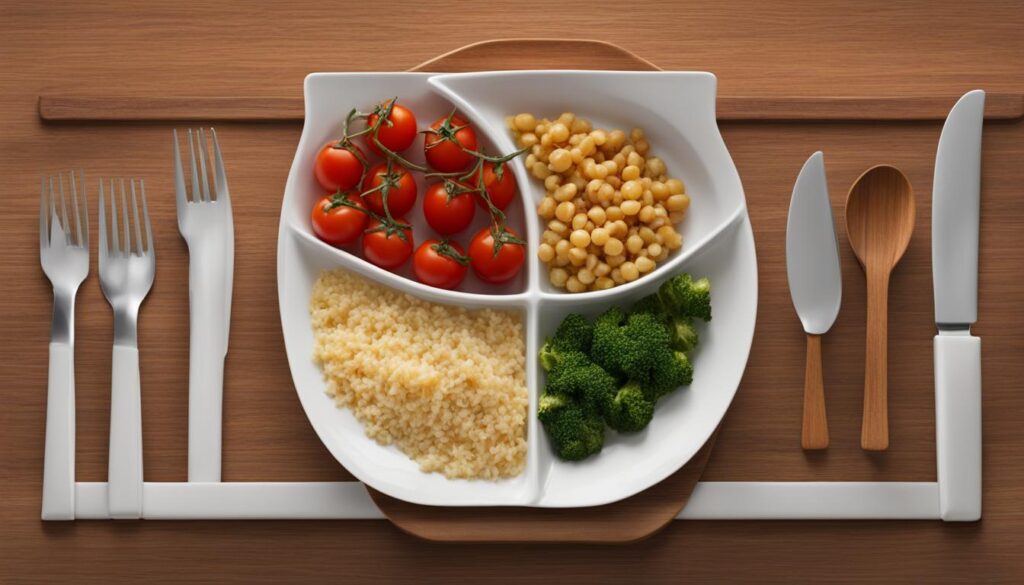
When it comes to portion control, it’s crucial to prioritize proper portion sizes to ensure you feel full and satisfied without overeating. Here are some tips to help you control your portions effectively:
- Read nutrition labels: Take the time to read and understand nutrition labels on food packages. This will help you make informed choices and determine the recommended portion sizes for different foods.
- Plan your meals: Planning your meals in advance can help you maintain portion control. By prepping your meals, you can measure and portion out the exact amounts of each nutrient you need, reducing the risk of overeating.
- Use portion control plates or containers: Invest in portion control plates or containers that are divided into specific sections for proteins, grains, and vegetables. This visual guide will help you allocate the right amount of each food group and maintain proper portion sizes.
- Measure with precision: Utilize a kitchen scale or measuring cups to measure your food portions accurately. This ensures you’re consuming the appropriate amount of each nutrient and prevents unintentional overeating.
- Create an illusion of a full plate: Using smaller plates can create the illusion of a full meal, even with reduced food portions. This visual trick can have a significant impact on your perception of satiety, helping you feel content with smaller amounts.
By implementing these portion control strategies into your daily routine, you can maintain a healthy balance of nutrients and keep your calorie intake in check. Remember, proper portion sizes are instrumental in achieving your health and weight management goals.
What is a Portion Control Plate?
A portion control plate is a helpful tool designed to assist individuals in managing their food portions effectively. These plates are typically divided into sections, each representing a different food group, such as proteins, grains, vegetables, and fruits. By using a portion control plate, you can easily visualize and allocate the appropriate amounts of each nutrient, ensuring a well-balanced meal.
| Food Group | Portion Size |
|---|---|
| Proteins (e.g., lean meats, tofu) | One-quarter of the plate |
| Grains (e.g., rice, bread, pasta) | One-quarter of the plate |
| Vegetables | One-half of the plate |
| Fruits | Add as a side or dessert |
Using a portion control plate can help you develop healthy eating habits and maintain a balanced diet.
“Portion control plates are an excellent tool for visualizing proper portion sizes and ensuring a well-rounded meal.” – Nutritionist, Emily Smith
How to Get Started with Portion Control
Getting started with portion control may seem overwhelming, but with the right tools and strategies, it can become a simple and effective way to manage your food intake. Here are some tips to help you get started:
- Meal Planning: Plan your meals in advance to ensure you are eating balanced and portion-controlled meals throughout the week. This will help you avoid impulsive food choices and overeating.
- Use Portion Control Tools: There are various portion control tools available that can help you measure your food accurately. One popular tool is a portion control plate, which has designated sections for each food group, making it easy to visualize appropriate portion sizes.
- Consult with a Registered Dietitian: Working with a registered dietitian can provide you with personalized guidance and support to create a portion control plan that suits your specific needs and goals. They can also provide accountability and help you stay on track.
- Divided Meal Prep Containers: Invest in meal prep containers with dividers to portion control your meals in advance (check this post out). This will help you ensure that each meal contains the right balance of nutrients and appropriate serving sizes.
Remember, it’s important to consult with a healthcare professional before making any significant changes to your diet or exercise routine. They can provide you with personalized advice based on your individual health status and dietary needs.
The Role of Portion Size in Obesity Prevention
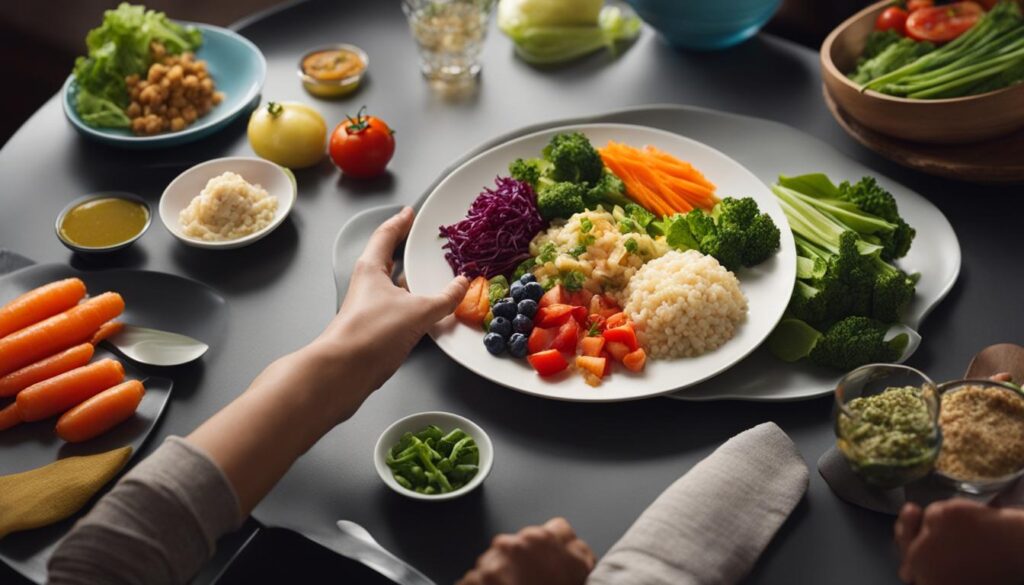
Proper portion control is a vital strategy in weight management and the prevention of obesity. Studies have consistently shown that providing individuals with larger portions can lead to increased energy intake, resulting in weight gain and the development of obesity. To combat this, it is important to educate individuals on appropriate portion sizes and provide them with effective portion control tools.
Teaching individuals about portion control methods helps them develop healthier eating habits and make more informed food choices. One effective way to promote portion control is by using portion control plates. These plates are designed with dividers that guide individuals to allocate the right amount of each food group, ensuring balanced and controlled portion sizes. Portion control plates also serve as visual aids, making it easier for individuals to understand and implement portion control strategies.
Another important aspect of portion control is the consumption of low-energy-density foods. This means choosing foods that are lower in calories but still provide a high volume, such as fruits and vegetables. These foods help individuals feel more satisfied while consuming fewer calories, making weight management easier.
On the other hand, it is important to limit portion sizes of high-energy-density foods, which are often high in calories but low in volume. These foods include items like fried snacks, sugary beverages, and desserts. By controlling the amount consumed, individuals can reduce calorie intake and maintain a healthier weight.
Overall, portion control plays a significant role in obesity prevention. By teaching appropriate portion sizes and providing tools like portion control plates, individuals can develop healthier eating habits and manage their weight effectively. Encouraging the consumption of low-energy-density foods and limiting portion sizes of high-energy-density foods further supports weight management efforts.
The Importance of Portion Control Plates
| Advantages of Portion Control Plates | Examples of Portion Control Plates |
|---|---|
|
|
Using portion control plates can be an effective tool in managing portion sizes and promoting weight management. These plates guide individuals to allocate proper portion sizes for each food group, making it easier to achieve a balanced diet. Several examples of portion control plates include My Portion Plate, Portion Perfection Adult Plate, and EatingReset Superfood Plate.
Portion control plates serve as visual aids and make portion control easy to understand and implement. By using these tools, individuals can effectively manage their portion sizes and support their weight management goals.
By embracing portion control methods and utilizing portion control tools such as portion control plates, individuals can take proactive steps towards preventing obesity and maintaining a healthy weight. With the right knowledge and tools, portion control becomes a manageable and sustainable approach to promoting overall health and wellness.
Conclusion
Portion control is a crucial aspect of weight management and promoting overall health. By understanding proper portion sizes, reading food labels, and utilizing portion control tools such as the food portion control chart, portion control plate, and portion control guide, individuals can make informed food choices and prevent overeating (check this post out). These strategies, when incorporated into everyday routines along with a balanced diet and regular physical activity, can lead to sustainable weight loss and the development of healthier eating habits.
Monitoring portion sizes allows individuals to manage their caloric intake and avoid consuming more calories than their bodies need. It also helps in preventing the consumption of oversized portions often served at restaurants, which can lead to overeating. By adopting portion control practices such as reading nutrition labels, planning meals in advance, measuring food accurately, and using smaller plates, individuals can effectively manage their portions and promote weight loss.
Portion control also plays a significant role in preventing obesity. With increasing portion sizes in the United States, it is important to understand appropriate portion sizes. Utilizing portion control tools like the food portion control chart, portion control plate, and portion control guide can help individuals consume the right amount of food and avoid overeating. By making conscious choices and opting for low-energy-density foods, individuals can maintain a healthy weight and reduce the risk of obesity-related health issues.
In conclusion, implementing portion control practices is essential for achieving and maintaining a healthy weight. By prioritizing the understanding and management of proper portion sizes, individuals can make positive changes to their eating habits. Incorporating the use of portion control tools, such as the food portion control chart, portion control plate, and portion control guide, can greatly assist in this process. With dedication and consistency, portion control can lead to long-term weight loss, improved overall health, and a happier, more balanced lifestyle.

